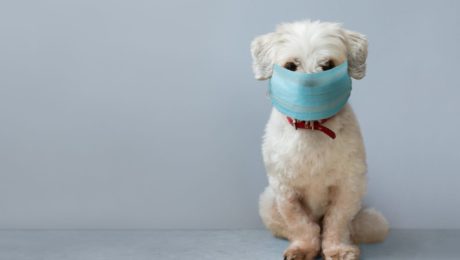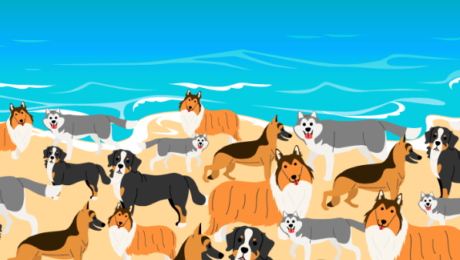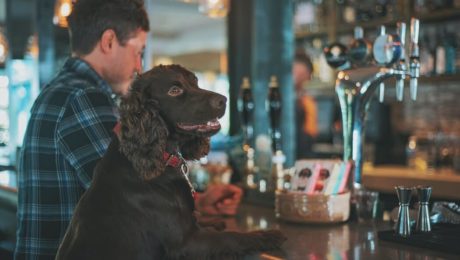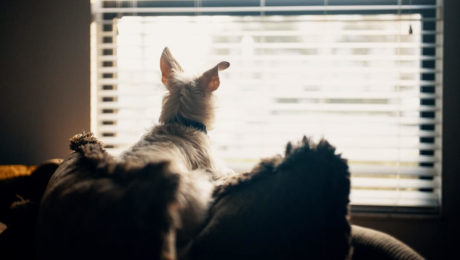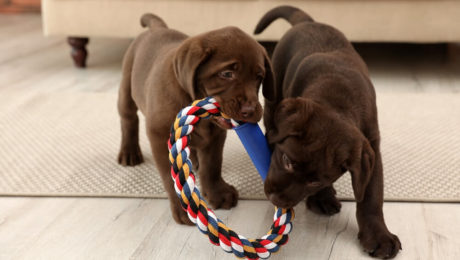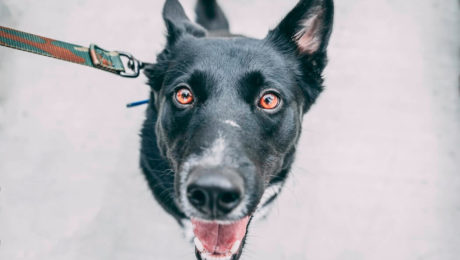How to Protect Your Dog From Theft

The demand for puppies dramatically increased during lockdown, with many suddenly having an abundance of time to train a new pet. However, the rise in people buying dogs resulted in huge price inflations. Since March 2020, puppies have surged in value by an average of £1,249.
The escalated puppy prices have unfortunately led to a 250% growth in dog theft nationwide. Some breeds are particularly at risk, with Chow Chows now worth an estimated £3,700 and golden retrievers more than doubling in price. Patterdales have increased in value by a staggering 328% too.
As well as the chance to profit from stolen dogs, the crime is also relatively low-risk for thieves. Although the maximum penalty for dognapping is seven years imprisonment, recent reports found that less than 5% of cases result in criminal conviction.
Unsurprisingly, this development in dog theft has left many owners worried and scared of losing their beloved family pet. To help put your mind at ease, Benchmark Kennels have put together a thorough guide on how to protect your puppy against theft.
Identify your dog
- Microchipping
Owners are required to get their dog microchipped and registered by the time they’re eight weeks old. If any of your details change, such as address or phone number, update your microchip account.
- Collars with your name, address and neutered information
Place a collar on your dog, with an ID tag that has your surname, address, and mobile number engraved. Don’t put your dog’s name on the collar, though, as thieves can use it to lure the pup away. Some collars also come with GPS tracking and can connect to your phone.
If your dog is neutered, mark this on the collar because it could discourage thieves who steal dogs for breeding.
- Photos of you and your dog together
Keep clear and up-to-date photos of your dog from different angles, with a groomed and ungroomed coat, in case of the worst happening. Take images of yourself with the pup, too, so you can prove ownership if necessary.
Dog walking safety
Many owners have become frightened to walk their dog after horrifying stories emerged of dogs being stolen in muggings.
To enhance your and your dog’s safety when out and about:
- Vary your walk schedule and routes as thieves may try to learn your routine.
- Always remain aware of your surroundings by staying off your phone and not wearing headphones.
- Walk with someone else where possible.
- If alone, carry an alarm or referee whistle to help you feel more secure and deter attempting thieves – but only use when necessary as it can scare your dog.
Be extremely wary of strangers asking for information about your dog, wanting pictures with the pup, or trying to stroke them. If someone suspect approaches you or a car slows down next to you, don’t walk home straight away as they might follow you. Report any suspicious incidents to the police.
Only let your dog off the lead if they’re unlikely to stray away from you. In case they do run far ahead, dress them in a reflective coat during winter to help you spot them and train them to return on command. Alternatively, use an extendable lead so they can run around without getting lost.
Don’t leave your dog alone
Leaving your dog alone in public, such as in a car or tied up outside a shop, makes them vulnerable to theft. Try to attend dog-friendly establishments so they can stay by your side.
Enhanced garden security
Unfortunately, even when you’re in your own space, you still need to take precautions. According to The Pet Theft Census, 52% of dogs are stolen from their gardens.
Never leave your dog in the garden unsupervised and avoid placing them in front gardens, as this makes it easier for thieves to snatch them.

Lock any gates you have and fit them with bells to alert you when someone opens them. Ensure your fence or other garden boundary is 6ft high with no gaps to keep your dog from escaping and make it harder for thieves to access the garden.
If your dog loves being outside, invest in a secure dog kennel for them to relax in. Benchmark Kennels offer a range of sheltered and insulated outdoor kennels secured with two pad bolts per door. Place the kennel near your property rather than at the bottom of the garden. Always keep the kennel locked and fit it with a bell or alarm to warn you if someone’s trying to break into it.
To make your home safer at night-time, fit outdoor lights in your front and back garden that activate when someone approaches the house, which can deter thieves. Install CCTV for outside your property too.
Always keep your doors and windows locked and shut your curtains and blinds when you’re out. Try to avoid indicating that a dog lives at your home, such as leaving toys in the garden or hanging ‘beware of the dog’ signs.
Safety inside the home
Keep your dog safe at home by installing a security system with an alarm and cameras inside the house so you can check on your dog when you’re out. With smart security devices, you can view the camera footage remotely on your phone and receive notifications if any unusual activity occurs.
Be vigilant of strangers coming to your front door, especially if they’re inquiring about your dog, as they could be thieves assessing your home.
Trustworthy dog-sitters
Dogs who are frequently left alone are vulnerable to theft but hiring a dog-sitter or walker can put off potential thieves. If you can’t use a family member or friend to look after the pup, choose someone from a reputable and licensed company. Check their references, qualifications and whether they’re certified with any professional organisations.
Social media security
Many owners love to show off their puppy on social media, with many dogs becoming Insta-famous, but this can put them on a thief’s radar. If you post about your dog online, always blur out their ID tags, keep your account private and avoid using location tags or hashtags. Never respond to a stranger messaging you about the dog, either.
What to do if your dog is stolen
Implementing these precautions can lower the risk of dog theft, but it’s still a possibility. If the worst happens and your dog is stolen, act quickly to increase your chance of finding them.
Follow the below steps:
- Ring 999 to report the theft and get a crime reference number
- Report the theft to the microchip database
- Report the theft to the local council’s dog warden (if they have one)
- Tell local dog walkers to keep an eye out
- Post about your missing dog on local Facebook groups
- Post about the incident on your social media accounts and ask friends to share them
- Inform local vets
- Report the theft on missing animal sites
- Contact local animal shelters and rescue charities
- Hang posters in your area with clear photos and contact details
Depending on your pet insurance policy, you may be able to claim advertising fees and reward costs to help you find your dog. However, don’t specify the reward amount as this could attract hoax callers or put the dog at risk of theft in the future if found.
In response to this worrying increase in dognapping, more than 300,000 people signed a petition calling for tougher penalties. Until further action is taken, owners need to be highly cautious when out with their dog, enhance their home security, and prepare for the worst.
Need an outdoor kennel to keep your dog safe in the garden?
Outdoor kennels are a great way for your dog to enjoy being outside safely. At Benchmark Kennels, we offer a range of secure and spacious kennels that you can customise to suit the dog’s breed, personality, size, and other requirements.
You can order a wooden or WPC eco-thermal dog kennel directly from our website today or contact us via phone to find out more about our excellent range of kennels.
- Published in Blog
Vote for Your Favourite Dog Breed
One of the most hotly debated topics in the canine world is which breed is top dog. So we’ve set up a poll for you to vote for your favourite breed.
If you can’t see your choice on the list, tick ‘other’ at the end of the answers and add your favourite.
We’re also interested in whether you’ve changed your habits due to restrictions – you might be unable to walk as much due to travel restrictions. Or perhaps you’ve avoided shops by purchasing dog subscription boxes.
At Benchmark Kennels, we are always interested in any tips that we can share to benefit your dog’s care. Through this survey, we hope to see some popular ways that owners have looked after their dog during restrictions.
We will share the results in a couple of months when we’ve had plenty of respondents!
- Published in Blog
How to Make Your Christmas Dog-Friendly
The festive period is always an exciting time of year, especially when spending it with your adorable dog. Whether you’re celebrating your pup’s first Christmas, or your family dog has been with you for years, ensuring your home remains pet-friendly is key.
While Christmas might look a little different this year, with big social gatherings on hold, there are still many ways the season can feel chaotic for your four-legged family member. To avoid causing your pooch stress, read Benchmark Kennels’ tips on how to prepare them for the festivities.
Decorate your home gradually
Although it’s tempting to deck your entire house out with wreaths, ornaments, tinsel, and lights in one go, this can be quite unsettling for dogs. Instead, introduce the decorations gradually and leave your Christmas tree bare for a few days so they can adjust to their environment’s change.
Christmas tree precautions
Christmas tree pines can get stuck in paws or become lodged in a dog’s throat if ingested so ensure you sweep any fallout from the tree straight away or opt for a fake tree instead if you have a new puppy around. Dogs can sometimes use Christmas trees as urinals too to mark their territory, so avoid leaving them with it unsupervised and conduct a refresh on toilet training if needed.
To dog-proof your Christmas tree:
- Leave the bottom branches bare.
- Place any fragile ornaments towards the top of the tree.
- Avoid hanging any edible decorations, e.g. candy canes and chocolate novelties that are poisonous to dogs.
- Hide any electric wires they could chew.
Never leave Christmas lights switched on unsupervised. - Anchor the tree to the floor or wall to prevent it falling over.
Avoid toxic plants
Most Christmas plants, including mistletoe, holly, and poinsettia, are unfortunately unsafe for many animals, including dogs. However, some suitable options can make your home look just as festive, such as red roses, Christmas Cactus, and Autumn Olive.
Create a dog-safe haven
It’s important to provide your dog with somewhere quiet they can retreat from the festive excitement and be undisturbed. An outdoor kennel allows your dog space to relax, play, or sleep in private. As well as providing warmth, safety and shelter, kennels are insulated and big enough for dogs to play in. Being outdoors can also be calming and reduce any excess energy that comes from being cooped up indoors.
Many people light fireworks through the Christmas season which you, unfortunately, can’t avoid. To help your dog feel as relaxed and safe as possible, why not turn an indoor crate into a cosy den. Make it comforting by filling it with soft bedding, toys, and water. Then cover it with blankets to muffle the noise and dim the lights of the fireworks. It’s important to ensure your dog can still see out of it and leave if they choose to so they don’t feel trapped.
Christmas day adjustments
It’s common for usual daily errands and habits to be forgotten about on Christmas day but don’t let this interfere with your dog’s routine. Continue to walk and feed them at the usual times to avoid causing any unnecessary upset or disasters with dogs stealing your Christmas dinner.
If you’re hosting guests or you have young children, make everyone aware of how to keep your dog from getting stressed. For instance, remind them not to approach the dog when in his den or to feed him unsafe food.
While we indulge in lavish food during this period, it won’t benefit your pup to do the same. A lot of the typical Christmas food for humans such as mince pies, chocolate, and onion stuffing isn’t dog-safe, so don’t sneak them any under the dining table or leave unwashed plates out for them to lick. You can still give them a few dog treats, but a sudden dietary change such as a bowl full of turkey can cause stomach upset and lead to toilet accidents around your home.

Many Christmas dinners are followed by pulling crackers, using party poppers, and popping champagne corks, but these noises can be scary for your dog. You could either avoid these traditions altogether or ensure your dog isn’t near or is kept in an outdoor dog kennel when they’re happening.
Adapting your Christmas to suit your dog’s needs doesn’t have to disrupt your entire routine, but can stop them from getting overwhelmed and allow them to enjoy the festivities along with you.
Need a bespoke kennel for your dog to feel comfortable in this Christmas?
Benchmark Kennels are a manufacturer of bespoke kennels, giving dogs a secure and spacious place to stay outdoors when they need some peace and quiet. Each kennel can be customised to suit your dog and home perfectly in terms of size, shape and material.
You can order a wooden or WPC eco-thermal dog kennel directly from our website today or contact us via phone to find out more about our excellent range of kennels.
- Published in Blog
How to Familiarise Your Dog With Face Masks
As any dog owner will know, a global pandemic isn’t just difficult for us but can be hard on our pets too. One of the most difficult things for our furry friends to get used to is how different we look with facemasks on. Our dogs usually use our facial expressions to read and react to our emotions, so introducing masks all of a sudden can be confusing and frightening for pets.
However, as long as you familiarise your dog with facemasks slowly and patiently, your pets will soon come to see your facemask as nothing unusual, but part of everyday life. Even in unexpected circumstances, Benchmark Kennels are here to support you with the advice you need to keep your dog happy and healthy.
Step One: Start with the basics
Just like with anything new, introducing masks slowly and steadily will help your dog get used to them. To begin with, put your hand over your nose and mouth for a few seconds, make sure your dog can see what you’re doing, and then give them a treat. Letting your dog make the connection between your face mask and treats helps build positive associations, so they become more comfortable with the way you look while wearing one.
Step Two: Let your dog hear you speak
Because dogs learn how we feel by reading our facial expressions, it can be confusing for them to hear our voices, without seeing our mouths move. Once your dog has seen you lift your hands to your mouth, and they seem happy and comfortable, you can begin speaking to them or calling their name. When they recognise your voice even with your nose and mouth covered, you can give them another treat.
Step Three: Put your mask on casually
Now your dog has got used to the idea of your face being part-covered, it’s time to let them get acquainted with your mask itself. Let your dog see your mask, and watch you put it on. That way, they’ll get used to the whole process of you putting your mask on, and better know what to expect when you’re in contact with others wearing masks. Make sure to speak and act normally when you wear your facemask, too. Our pets can tell when we’re anxious, so acting as you usually would day-to-day when you’re wearing your mask lets them know there’s nothing for you or them to be worried about.
This part of the process might take a little more time, as your face being covered can be quite disorientating for your animals. You might have to repeat the process a few times, and you should be prepared with a supply of treats to help reward your dog when they recognise you.

Step Four: Let your dog see your mask for themselves
Once your dog is more used to seeing you in your mask, you can begin to wear it every now and again around the house. It’s important to do this casually, letting your dog see that your mask is just part of ordinary life, and so not something to be nervous about.
You should also leave your mask around the house when you can, so your dog can clearly see that it is going to be a regular part of your home, without being too wary of it. In this way, they can sniff out the situation for themselves, orientating themselves with the mask in their own time.
Step Five: Gradually introduce your dog to other people
It’s really important that your dog gets regular exercise during lockdown and as social restrictions continue. When you’re on walks, in the park or out and about, your dog is likely to interact with other dogs and their owners. To stop your pet feeling nervous or lashing out when you’re out in public, start off with a walk with a friend or family member you see regularly. Introducing familiar people in masks in the same way as you did will help your dog get used to the idea at a steady pace.
When you see anyone wearing a mask while you’re out walking, give your dog a treat. This will help them feel relaxed, and associate wearing a mask with something happy, rather than something they should be worried about.
Choose a custom-made kennel to suit your dog’s needs
Benchmark Kennels offer a range of WPC eco-thermal kennels to make sure your dog stays happy and healthy. Each of our kennels can be customised to become the perfect fit in your home. Get in touch to order your luxury kennel today.
- Published in Blog
International Dog Day Brainteaser: Spot the Yorkie on the Beach
Where’s the elusive Yorkshire Terrier on this beach?
With international dog day fast approaching (the 26th!) Benchmark Kennels have produced an exciting brainteaser for the dog loving puzzle pundits among us. Somewhere below, there’s a Yorkshire Terrier hidden among the bigger dog breeds on this busy beach.
It took us 30 seconds to spot the Yorkie – how long will it take you?

International Dog Day was originally started as National Dog Day in the USA, before becoming a day of celebration for dog lovers all over the world.
Whether you’re considering donating to assistance dogs, or fancy treating your pooch to a really long walk, the 26th of August is a great excuse to splash out on your favourite canines.
This year, we’ve chosen to increase awareness around one of our favourite breeds.
The Yorkshire Terrier has seen the largest reduction in kennel club registrations of any breed over the past thirty years, falling 97% from 24,015 registrations in 1990, to 644 in 2019. We’ve created this spot the Yorkie brainteaser to highlight the reductions in this iconic breed’s registrations across the UK.
Let us know how quickly you find this Yorkie – have you beaten our time?
- Published in Blog
The Top Five Insta-Famous Dogs of Lockdown
Throughout the past few months of lockdown, man’s best friend has become the centre of life at home for many of us, whether we’re on furlough, isolating, or working from home.
Despite cats (boo) entering the new year being searched for more than our beloved canines, online interest in dogs has overtaken that of the felines, which means statistically, dogs are absolutely preferred by the UK public to cats.
If you aren’t already filling the void left by seeing fewer dogs outside of your own household during the lockdown period, Benchmark Kennels have highlighted the top five most insta-famous dogs for you to check out…
1. Jiffpom – 10.5 million followers
https://www.instagram.com/p/B-B7h68lXpO/?igshid=qmkjautq9ai7
Coming in at the top of this list is Jiff the Pomeranian, with over 10.4 million followers on his main account, and a combined 30 million across all of his social media.
While pomeranians are the smallest member of the Spitz dog family (which includes Malamutes and other sled dog breeds), Jiff really packs a punch in the influencer world. With two Guinness World Records under his collar, along with a feature in Katy Perry’s ‘Dark Horse’ music video, this star is more talented than most!
Head on over to Instagram and follow Jiff @jiffpom to see regular photos and videos of this little pomeranian living the high life in Los Angeles.
2. Doug the Pug – 4 million followers
https://www.instagram.com/p/CCEM_FIpCqY/?igshid=ltd7vdr73ucs
Following up in second place is Doug The Pug, with four million followers on Instagram.
As the most popular breed of toy dog, pugs have dominated internet culture for years. Doug is different, however. Officially referred to as a ‘celebrity dog,’ this pug won last year’s People’s Choice Award for Animal Star.
Not content with Instagram fame, he also has one billion video views over at Facebook, where he stars in remakes of iconic movie scenes from IT to Frozen. Yet another music star, Doug has been featured in Katy Perry’s ‘Swish Swish’ music video, as well as Fall Out Boy’s ‘Irresistible.’
With daily posts uploaded to Instagram, be sure to follow Doug the Pug @itsdougthepug for a glimpse into celebrity dog lifestyle.
3. Maru the Shiba, Shinjiro Ono – 2.6 million followers
https://www.instagram.com/p/CB_4Mk4BVcy/?igshid=v3x6tzf3oqv6
Maru the Shiba is the next featured dog, with an impressive 2.6 million followers on Instagram.
While he may not be as well known in music industry circles, this Shiba is arguably the cutest dog on Instagram. With his fluffiness only matched by his constant grin, Maru is practically the poster pup for happiness. Maru is, in fact, Japanese for round, a fact that only makes him all the more destined to be the cutest dog on this list.
Follow Maru the Shiba’s adventures over on Instagram @marutaro for regular videos of the pooch deemed to be ‘the best dog in the world’ by Time Magazine.
4. Tuna – 2.1 million followers
https://www.instagram.com/p/CChDG9jB9J_/?igshid=1raxuqoxi0b23
Tuna is the next featured Instagram star, with 2.1 million followers, and a heartwarming backstory.
Abandoned just after birth, Tuna shot to fame in 2012 when his new owner Courtney made him an Instagram account. Because of his unusual, albeit adorable, appearance due to overbreeding, and a tough start in life, Tuna has used his Instagram fame to raise money for animal rescue groups, while also promoting animal welfare.
Find this internet celebrity travelling across the world, while still having time to be featured on This Morning, and at launch parties in top tier locations such as the Ivy Chelsea Garden Restaurant.
For further inspiration from Tuna, follow @tunameltsmyheart.
5. Loki the Wolfdog – 2.1 million followers
https://www.instagram.com/p/B-NRGOsJQcZ/?igshid=bc338i9s6i2a
The biggest and final pup in this roundup is Loki the Wolfdog, with 2.1 million followers on Instagram.
As his name would suggest, Loki is indeed part wolf, with some husky and malamute ancestry added to the mix. This wild side results in Loki requiring more exercise and time outdoors than most dogs. Luckily for him, owner Kelly is an outdoor aficionado, travelling the wilderness and taking stunning photos that provide us with a glimpse into the wilder side of life, and an escape from the sofa during the lockdown.
Follow Loki @loki for more on the road pics!
Chat to the Benchmark Kennels team today!
Get in touch with us on social media to let us know if your favourite Instagram dog made the list, and to share any dog pics that you have taken while we’ve all been stuck at home.
Benchmark Kennels manufacture bespoke dog kennels to suit dogs of all breeds, shapes and sizes. You can customise your outdoor kennel to be as luxury or minimal as required, with us offering a range of materials from wooden to WPC eco-thermal kennels with extra insulation. You can order a kennel direct from our website or get in touch with us for further advice on the best kennel for your dog’s needs.
- Published in Blog
The Top Five Dog-Friendly Pubs in Yorkshire!
Back in May in the midst of lockdown, the Benchmark Kennels team asked you to get involved and tell us your favourite dog-friendly pubs around Yorkshire. It was a wonderful opportunity for dog-lovers and owners alike to honour our favourite dog-friendly pubs and help spread the word about these welcoming and cosy places to grab a pint.
First of all, thank you! Our readers didn’t disappoint, with more than 300 of you placing your votes and telling us why your locals are so special to both you and your animals – we absolutely loved hearing from you.
With Boris deciding to lift some lockdown restrictions on 4th July and many pubs now reopening, its the perfect time to see who our winners are and give credit to the top five and much-loved pubs of Yorkshire.
Drum roll, please…
1. The Crown & Cushion, Welburn
The Crown & Cushion in Welburn, North Yorkshire really do take the crown on this one. They received the majority of votes from dog owners and locals due to their gorgeous setting and friendly approach to dogs joining their families for food or drinks.
With the building dating back to the 18th Century, its a stunning environment offering locals a place to pop in for a casual drink after a long walk or get dressed up and visit for a fine dining experience.
In winter, the open fires make the pub a cosy and welcoming place to spend a Sunday, and in summer, the rear terrace is ideal for drinks in the sun.
Welburn village is located in the district of Rydale, not far from Malton and York. It’s easy to access from the A64 or can be found via foot with there being many popular walks and bird-watching spots around the area that can start or finish at the Crown & Cushion.
2. The Wheatsheaf Inn, Carperby
Next up is The Wheatsheaf Inn in Wensleydale, set in the beautiful Yorkshire Dales National Park and hugely popular with avid walkers and explorers. There is an abundance of Yorkshire attractions around the area making it the perfect place for a pint at the end of a long day either spent hiking in the dales with your furry friends or simply mooching around the quaint village shops.
If you’re planning a big walk with the dog and need a place to rest your head afterwards, you can even book a room with your pooch, with many of their single, double and family rooms being completely pet-friendly and offering a home-from-home experience.
3. The Fountain Hotel, Hawes
Another North Yorkshire pub comes in at third – The Fountain Hotel in Hawes. This hotel and local prides itself on its wholesome and home-cooked pub grub, welcoming all dogs and children with open arms.
Popular with sports fans, the pub hosts three screens showing live sport, ideal for watching premiere football which has recently made its post-corona comeback.
The pub is a favourite of both locals and visitors to the town, with many calling in for a drink or staying the night after a walk around the lovely village of Wensleydale and the Yorkshire Dales.
4. The Oak Tree, Helperby
In at fourth is The Oak Tree in Helperby, a village full of character and within reach of a range of lovely walks along rivers Ule and Swale or along the old railway line. You can book a room with your dog or simply visit for a few drinks after a nice stroll, with a huge array of local beers, hand-pulled ales and delicious wines to choose from.
For those looking for a venue for a special occasion, you can even hire out a private party room to host birthdays, cocktail parties or any family gathering and bring your dogs along.
5. Rose & Crown, Sutton-on-the-Forest
Last but by no means least is the Rose & Crown. Located in the picturesque village of Sutton-on-the-Forest in North Yorkshire, this pub is the heart of the village community, being the last standing pub in the village and offering a mean Sunday lunch.
Known to serve some of the best pub food in York, they offer curry nights, steak nights and fresh fish Friday’s – all of which welcome dogs and families to join in. If you’re looking for an affordable place to stop off for a pint and a bite to eat after a long day out around York with it being just eight miles out of the city centre.
If you can’t see your favourite on the list, don’t be disheartened, it was a close call! There were tons of runners up that are equally as beautiful places to call in for a drink with your dog or family, like the Trafalgar Bay in York and The Coverbridge Inn in East Witton.
Get in touch with us on social media to let us know if your favourite dog-friendly pub made the top five and whether you’re planning to brave the pubs post-lockdown or stick to drinks at home for now.
- Published in Blog
Lockdown Tips: How To Avoid Dog Separation Anxiety
Lockdown, while being a scary and unusual time for many, has allowed both new and experienced dog owners to spend lots of quality time with their pets, strengthening bonds and giving owners plenty of time to practise some perhaps neglected training. It’s been wonderful for our dogs to have us around, whether you are working from home and they are happy to sit by your side until their walkies or you’re on furlough and have been able to give them your undivided attention.
Despite this, it’s important to keep in mind that the period of lockdown is gradually coming to an end and as people start to return to work our dogs are likely to feel confused and abandoned after such a long period of being around their humans 24/7. If you have welcomed a new puppy into your home or you have a dog that struggled with being separated before lockdown began, now is the time to start easing your dog into normal life and make sure you don’t go from one extreme to another.
Benchmark Kennels are here to clear up any confusion you have around trying to avoid separation anxiety and offer some clever ways to accustom your dog to spending time alone without having to necessarily leave your home entirely.
What is separation anxiety?
Before you start trying to combat and avoid separation anxiety, you need a basic understanding of what it is and what it can entail if you allow it to escalate. Dogs in the wild are pack animals meaning it is in their nature to enjoy spending time as part of a group rather than alone. This natural instinct is still there, meaning domesticated dogs can develop separation anxiety as a result of spending too much time in the company of their owners and believing that every time you leave the room you are essentially leaving forever. By introducing periods of prolonged separation and encouraging your dog to have some independence as a puppy and an adult, you will make life a lot easier when it comes to going to work or heading out to a place where dogs aren’t allowed.
How your dog reacts to being left alone will be dependent on their breed and upbringing, but it is also largely a result of how they are raised and their early experiences. While it may be tempting to spend every waking minute with a new puppy having plenty of cuddles and playtime, this will only lead to issues further down the line. For dogs that haven’t been left alone or trained to spend time without you being closeby, separation anxiety and your dog’s distress can be displayed in a number of ways such as barking, crying or whining, chewing or general destructiveness and going to the toilet indoors – all behaviours that can be hard to deal with and can even harm the relationship between you are your animal.
How to avoid separation anxiety after post-lockdown…
Develop independence
If you have a new lockdown puppy or your dog has become your little shadow during the lockdown period, now is the time to start introducing periods of alone time and encourage independence. You don’t have to go out of the house to do this either, simply leaving your dog in another room or outdoors to play and explore without you being closeby is enough. Try to extend the amounts of time you separate yourself from your dog with the end goal being your dog staying calm and relaxed whether you’re in the room or not. Make sure to leave plenty of chew toys such as Kong toys stuffed with treats or peanut butter and a comfy bed or crate for your dog to rest and feel safe while you’re gone.
Some other ways to encourage independence is to make sure your dog sleeps in their bed rather than next to wherever you are in the home and try to stick to a consistent routine, including a ‘quiet time’ for your dog to sleep without you there.
Dog kennels
Another way to avoid causing dog separation anxiety is by using indoor or outdoor dog kennels. Kennels are a perfect way to give your dog alone time outdoors without you having to keep an eye on them, leaving you an opportunity to tick off any jobs around the house or run any errands. By putting your dog in their kennel regularly, it will become a part of their daily life and your dog will start to view their kennel as their own territory to play or relax without needing attention from you.
Shared care
While all dogs will have a favourite person, usually being whoever brings them home for the first time or who feeds them, discouraging your dog from becoming too attached to one family member can help to ease separation anxiety. To do this, make sure all members of your household get involved with the daily care, feeding, walking and playtime with your dog. This way, when their favourite carer is at work or in a separate room your dog won’t display signs of anxiety or problem behaviours.

This is an especially important thing to keep in mind if you plan to use dog sitting or dog walking services after lockdown, as your dog will be difficult to manage if they are only familiar with being around one person.
Regular exercise
This may go without saying, but taking your dog for a big walk at least once a day is essential for their physical and mental wellbeing. A dog that has excess energy to burn is far more likely to freak out, chew your furniture or bark when left alone than a dog that has had plenty of exercises before you head out. As the lockdown rules have started to be lifted, try to get back into a strict routine of taking your dog for a big walk before you go to work so they can sleep it off for a big chunk of the day until you return.
Positive techniques
Finally, it’s important to remember that once a dog has developed separation anxiety, it is difficult to get rid of. You should never punish your dog for the behaviour they display while you’re out as your animal won’t understand why or what they are being punished for. Instead, don’t pay your dog any attention when you get home to avoid making a big deal out of the fact you’re together again. Over time, your dog should start to learn that being apart isn’t something to be distressed about.
Order a bespoke wooden dog kennel for post-lockdown today!
If you’re planning to go back to work soon or you just want to reintroduce a routine to help to avoid or ease your dog’s separation anxiety, an outdoor wooden or WPC eco-thermal dog kennel is an ideal solution. They are secure, insulated and are bespoke-made to suit the size and breed of your dog, whether you require multi kennels or singular dog kennels to house your animals and keep them out of harm’s way.
Order your bespoke kennel via our website today or give us a call for a quote!
- Published in Blog
Lockdown Tips: Keeping Your Dog Fit At Home
Continuing our series of essential lockdown tips to keep your dog happy, healthy and engaged throughout the boredom of national lockdown, we’re focusing on the most simple and effective ways to keep your dog healthy and fit while largely stuck at home.
Depending on your pets’ usual activity levels, the activities you try might vary in length and intensity, they may be motivated by simply the promise of walkies with their human or need to be encouraged using small treats or a favourite toy, ball or game. There are no hard and fast rules when keeping your dog at peak physical fitness, because all canines are different, with their personalities and individual motivations. The most important consideration is to enjoy the quality time you and your dog spend together during quarantine, whether you choose long walks, training, play, enrichment activities or diet changes.
With that spirit in mind, Benchmark Kennel’s have put together a mini-guide to maintain your dog’s fitness with a bunch of helpful tips and handy advice so you can get active together at home while prioritising the safety and wellbeing of yourself, your family and your pet.
Long Walks
It’s a well-known fact of life that most dogs love the many hours spent walking with their humans in parks, along streets, in cities and deep in the countryside. In normal times there are almost no end of places you and your dog can venture, where they can run, chase, play and burn off all that extra energy which has them bouncing off the walls if gone unspent.
Although it’s not advisable to go wandering miles from home or driving to another county altogether and widening the margin for error in terms of staying alert, there are sure to be many routes in your local area to explore safely.
Going off the beaten track to the parkland of heritage sites is a great way to soak in some culture outdoors and give your dog lots of space to run, play and enjoy some much-needed freedom. These areas often possess large trees for quality stick hunting, lots of undergrowth for natural sniffing, and active wildlife to trigger your pets’ hunting instincts without allowing them to chase or hurt any small animals. On top of this, your dog may have the opportunity to greet and interact with other canines (provided your respective households don’t get too close) which they are sure to have missed during the quarantine.
That said, if you wish to skip the crowds, the best time to grab the lead and get running to your local green space is after 5 pm, ensuring a quieter environment so you and your dog can minimise contact with others.
Training
As previously mentioned in our lockdown series, being stuck at home provides you with the perfect opportunity to focus back on training basics. It’s never too late to revisit the simple things you might have been overlooking or correct bad behaviours you might not have had the time to deal with before the pandemic – with the added benefit of burning calories, improving concentration, and helping them stay active.
One of the best ways to get started, whether your dog is elderly, a pup or any age in between. Though just like humans, older dogs are known to have a superior attention span when compared with very young puppies, is to teach or reaffirm the seven most important commands: no, leave, sit, stay, come, and down. These can be exceptionally useful in almost any scenario you can imagine in which your dog is physically active, both indoors or out.
Finding the right training techniques for these commands is largely trial and error, and should be tailored to your dog, based on how fast and efficiently they learn, how well they remember commands and, if they have been trained before, their motivations.
All training or teaching of tricks should be carried out using small treats or their favourite toys as encouragement, using hand motions as a signal for your dog to position themselves in a certain way or follow you in a particular direction. You may also want to use sound, clicks, claps and whistles to communicate with them, depending on the rapport you share and what your pet responds most positively to.
It’s advisable to begin training in a quiet area so neither you or your dog become distracted, such as your garden during the morning or early evening.
Playtime
Although it might seem obvious that playtime makes for a great opportunity for your dog to keep fit while having fun, it’s an activity that many pet owners find all too easy to overlook or trivialise. Dogs get bored just like humans, so the rich engagement potential that play provides can alleviate their stress and activate essential brain functions while getting them running, chasing, fighting their toys and living their best canine lives.
Make sure you have their best toys on hand, it’s one thing to watch your dog play alone or with their companion dog (or dogs), but interacting and joining the play yourself adds a new layer of joy for your pet who sees you as the leader of their little pack.
A range of toys will do, for example: chasing a ball allows them to use concentration, understand spatial awareness and increase their speed, building lean muscle mass and burning fat. Tug of war improves their strength and lets them tap into their primal resource instincts. Flirt poles have your dogs bounding, jumping, spinning and chasing; increasing their heart rate, endurance and agility.
However you choose to make playtime a 3D, active and pack-building experience, it’s important to note that wherever you lead, your dog will follow. Your attitude, expressions and energy really will define how exciting, fulfilling and engaging play activities are for you and your dog.
Enrichment
A more relaxed facet of playtime that is often forgotten is enrichment. The definition of enrichment is to decrease boredom and behavioural problems through the constructive use of interesting objects, smells, sounds, flavours or games so that even when your dog is relaxed, they remain active, engaged and fit.

There are many ways to enrich your dogs’ experience of lockdown, the most physically powerful are assault courses, promoting agility and speed. They can be made easily using children’s crawl tubes, slides, and even bamboo sticks staked into the lawn. Another solution is Kongs (a chunky and hard-wearing toy that is perfect for garden play) which can be stuffed with treats and frozen, making them ideal for hot weather as we head into Summer. If you’re feeling particularly creative, allowing your dog an area of your garden, sandpit or scrubby area to dig is an inventive option – we apologise in advance for the thorough bathing they’ll need afterwards though.
Whatever method you choose, you can guarantee your dog will have used their reserves of excess energy through physical and mental stimulation, tiring them out and helping them settle better during those long lockdown evenings.
Diet
The single most effective way to help your dog stay fit during lockdown is to provide them with a healthy diet, promoting their wellbeing and shedding unnecessary fat and additives.
Removing man-made ingredients from their bowl and replacing indulgent and often fat-filled red meat-based wet food with lean, cooked white meat like chicken and turkey with the bones and skin completely removed. Fish can also be included in your dogs’ new diet, such as tuna, sardines and salmon, as can leafy greens, eggs, whole grains and vegetables, bringing a nutritional balance to their feeding times.
Instead of sweet treats, exchange this habit for a tiny square of juicy fruit like melon, apple, banana, pear, etc. Take care to keep portions small, as large amounts of sugar and fruit can cause stomach upset and diarrhoea.
Need a bespoke kennel large enough for other lockdown dog activities?
Benchmark Kennels are a manufacturer of bespoke dog kennels, giving dog owners of all breed types, sizes and temperaments a secure and spacious place to stay outdoors. Every kennel is custom-made, meaning you can choose the exact size, material, properties and architecture of the kennel itself to ensure it suits your dog and the outside of your property.
You can order a wooden or WPC eco-thermal dog kennel directly from our website today or contact us via phone to find out more about our excellent range of kennels.
- Published in Blog
Lockdown Tips: Training A Dog To Walk On A Lead
Lockdown is continuing to pose some restrictions on everyday life and, with us cooped up at home for most of the time, your dog may be going a little stir crazy with excess energy. A dog that is not mentally or physically stimulated can start to display boisterous and problematic behaviour, so what better time to go back to basics and train your pooch to walk on a lead, rather than allowing them to tear about your home.
Many people think that dogs know innately know how to walk on a leash, but this skill is one which needs to be learned through consistent training and practice. Dedicating some time each day to practising on the lead means that next time you go for your daily walk, you’ll both be calm enough to value every moment. This skill is especially important if you have a very young or large breed of dog who may end up dragging you down the street without the correct training.
Here are some expert tips from Benchmark Kennels for training your dog to walk safely and calmly on a lead without tugging. Once you have used the right positive training techniques and mastered training a dog to walk to heel, your daily dog walks will be far more enjoyable and stress-free for both you and your furry companion.
Introduce your dog to the collar and lead
Begin by allowing your dog to get used to wearing its collar around the home. If you have had your puppy for a few weeks and are getting ready to take them outdoors for the first time, start putting on their collar for them to wear around the house. The feeling of a collar will be unfamiliar to your dog at first, but after a while, they will hardly notice they are wearing one at all. Your dog can wear its collar for short periods of time inside the house while you are playing, giving them treats and making them feel comfortable. It’s best to start off with lightweight and flexible collars so your dog does not feel restricted or uncomfortable and make sure the collar is not too tight.

Once your dog is not fazed by the collar, you can bring the lead into the picture. Have plenty of treats to hand and practise walking around your home and garden slowly with your dog. Make sure not to pull your dog around with the lead and instead let them walk and move at their own pace, keeping the lead loose so your dog is less aware that they are being restricted.
Training a dog to walk to heel
When your dog is fine wearing a collar and lead and moving around your home with you, you can try to tackle the walking technique. While it takes time for a puppy or untrained dog to heel on a lead, if you can get it right, your life on walks will be so much easier. Make sure you use treats, so your dog has a positive association with walking to heel and practise walking a few steps at a time before standing still and asking your dog to sit. This way, your dog will associate treats with walking by your side and sitting when you stop.
As soon as your dog turns and looks at you reward him with a little treat. After a few tries, you will notice your dog is not only focusing on you but is also coming over to you for the promise of a treat.
Introduce your dog to a distinctive cue sound that signifies food is coming. Some owners like to click and treat, some use an affirmative word like yes and others click with their tongue. Whichever method you choose to use is essentially the same, in a mostly quiet area free of sounds and loud background noise, with your dog on a leash, make the signature sound.
If your dog pulls ahead, do not pull them back or use force to stop them, simply stand still and wait till they stop pulling, then reward them with a treat and go again. Over time, your dog will realise that pulling doesn’t get them where they want to go any quicker and your walks will become far more enjoyable.
Venture outside
You are now ready to test your dog’s skills outside of your usual quiet space at home. There will be many challenges, smells, sounds, and sights to cause distraction, whether you are training a new puppy or an older dog that will test your dog’s newfound walking skills. It is important to be patient with your dog and keep the walks short for a while. If your dog starts to pull ahead on walks out of excitement, be consistent with your at-home training and stop walking, then reward your dog with a treat when they
Always keep your eyes on them, so if your dog looks likely to lunge at something, get suddenly distracted, or start pulling on the lead you can immediately move away or stop walking. If your dog follows suit, always reward them with a treat.
It can be difficult to be 100% consistent when out and about and training a dog to walk on a lead properly, so dedicating certain walks to be complete training sessions can be more effective. On these walks, make sure you are strict and firm with your dog, taking plenty of treats for rewarding your dog when it walks by your heel. On days where you are limited for time, use a different lead, and let your dog off to run around so they can get plenty of exercise without letting any of their lead skills slip away.
Need an outdoor kennel for your dog to spend time?
While dog walking training can be lifechanging for both dog owners and their animals, Benchmark Kennels are manufacturers of bespoke dog kennels, providing dog owners of all breed types, sizes, and temperaments with a secure and spacious place for dogs to kept outdoors. With each kennel being custom-made, you can choose the specific size, material, properties, and structure of your kennel to ensure that it suits your dog and property.
You can order a wooden or WPC eco-thermal dog kennel directly via our website today or enquire over the phone to hear more about our highly respected range of kennels.
- Published in Blog




